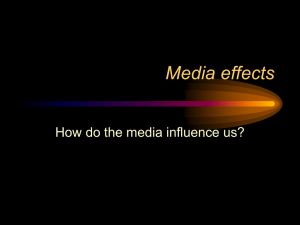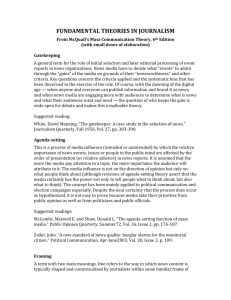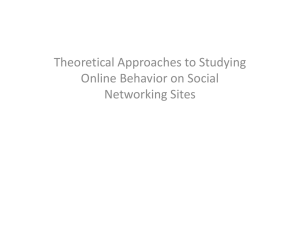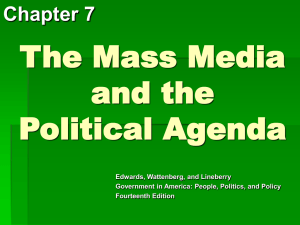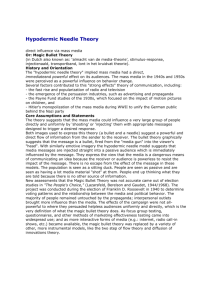Theory Reviews – Mass Communication Nov
advertisement
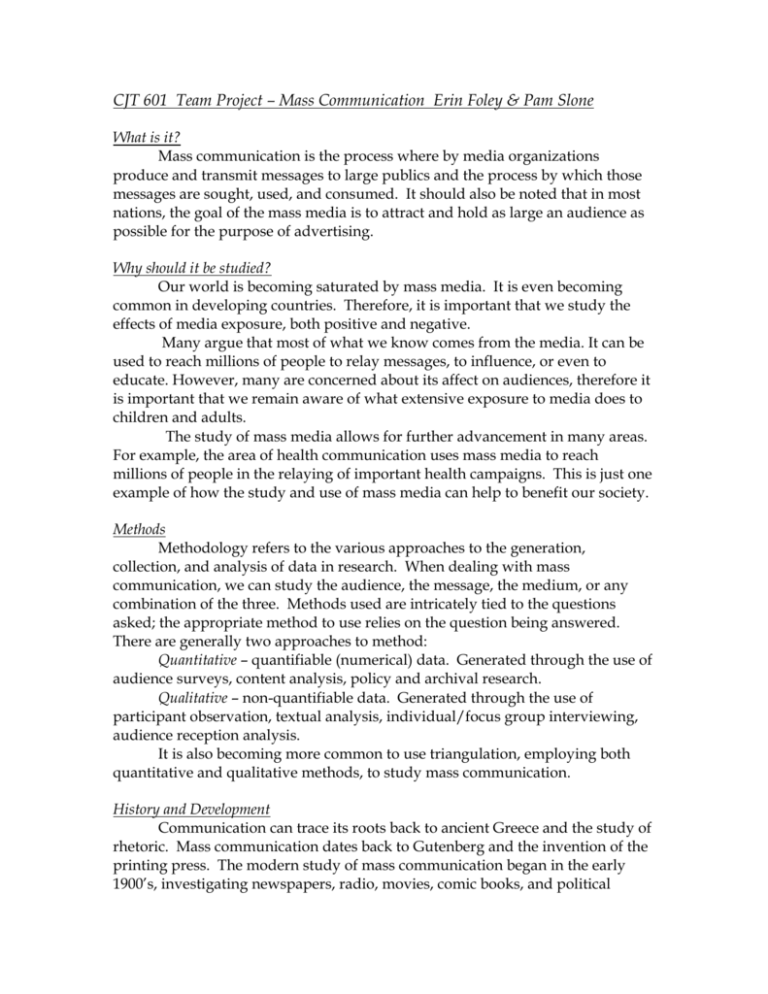
CJT 601 Team Project – Mass Communication Erin Foley & Pam Slone What is it? Mass communication is the process where by media organizations produce and transmit messages to large publics and the process by which those messages are sought, used, and consumed. It should also be noted that in most nations, the goal of the mass media is to attract and hold as large an audience as possible for the purpose of advertising. Why should it be studied? Our world is becoming saturated by mass media. It is even becoming common in developing countries. Therefore, it is important that we study the effects of media exposure, both positive and negative. Many argue that most of what we know comes from the media. It can be used to reach millions of people to relay messages, to influence, or even to educate. However, many are concerned about its affect on audiences, therefore it is important that we remain aware of what extensive exposure to media does to children and adults. The study of mass media allows for further advancement in many areas. For example, the area of health communication uses mass media to reach millions of people in the relaying of important health campaigns. This is just one example of how the study and use of mass media can help to benefit our society. Methods Methodology refers to the various approaches to the generation, collection, and analysis of data in research. When dealing with mass communication, we can study the audience, the message, the medium, or any combination of the three. Methods used are intricately tied to the questions asked; the appropriate method to use relies on the question being answered. There are generally two approaches to method: Quantitative – quantifiable (numerical) data. Generated through the use of audience surveys, content analysis, policy and archival research. Qualitative – non-quantifiable data. Generated through the use of participant observation, textual analysis, individual/focus group interviewing, audience reception analysis. It is also becoming more common to use triangulation, employing both quantitative and qualitative methods, to study mass communication. History and Development Communication can trace its roots back to ancient Greece and the study of rhetoric. Mass communication dates back to Gutenberg and the invention of the printing press. The modern study of mass communication began in the early 1900’s, investigating newspapers, radio, movies, comic books, and political communication – specifically propaganda and its effects. The predominant theoretical framework was originally based on the hypodermic needle/magic bullet theory (the idea that the mass media had direct and substantial effects on the message recipients). People were at the mercy of the mass media. This idea was replaced by the more sensible limited effects movement, which held that mass media had an effect on the public, but not in the direct, overwhelming way theorist originally hypothesized. Television then entered the scene, prompting study; this was followed by “new technologies,” such as e-mail, the Internet, chat rooms, posting boards, etc. The study of mass communication develops as new mass media are developed, implemented and accepted. Major Theories Agenda Setting (McCombs and Shaw) – This theory holds that editors, reporters, broadcast anchors, and the mass media in general, through choosing what news is to be displayed and how it is displayed “set an agenda” for the public, telling them what is important and what they should be thinking about. Cultivation Theory (Gerbner) – This theory is based on the idea the extensive exposure to media, overtime, gradually shapes our view of the world and social reality. It was through this theory that scholars discovered that with high exposure have a more fearful and distraught view of the world. Diffusion of Innovations (Rogers) – This theory examines how “innovation” are adopted, why one new thing, practice, or idea is well-received and another is all but ignored. It also takes into account the human decision-making process that leads people to adopt or reject. Knowledge Gap (Tichenor)– This theory is based on the idea that as infusion of mass media information into a social system increases, segments of the population with higher socioeconomic status tend to acquire this information at a faster rate than the lower status segments, so that the gap in knowledge between these segments tends to increase rather than decrease. Media Effects – This term actual could refer to several theories whose basic premise is that the media has an effect on its audiences, whether those effects are high or limited. Social Learning Theory (Bandura)– This theory is based on the idea of learned behavior through observation. Individuals observe the performance of a behavior and subsequently imitate it. Albert Bandura, its originator, is a psychologist. Spiral of Silence (Noelle-Neumann) – This theory says that the more an individual’s opinion differs from the “public opinion” (those views acceptable to voice in public), the less likely that individual is to express his/her ideas in public. When the gap between the public opinion and the individual’s opinion closes, the silence is more likely to be broken. Uses and Gratification (Blumer and Katz)– This theory is based on the idea that the audience has an active role in making choices and being goal directed in their media use behavior. The experience one gets from media depend upon their uses of the media and the gratification they are receiving. Who is studying it? Paul F. Lazarsfeld – media effects/social reinforcement Harold D. Lasswell- political communication Wilber Schramm – founder of modern journalism/communication education Jay G. Blumer – cultural imperialism, uses and gratifications Elihu Katz – uses and gratifications Everett Rogers – diffusion of innovations Elisabeth Noelle-Neumann – spiral of silence Steven H. Chaffee – political communication/media effects George Gerbner- cultivation theory Marshall McLuhan – attitude formation and change, technological determinism Maxwell E. McCombs – agenda setting Donald L. Shaw – agenda setting Stuart Hall – critical/cultural media studies Shearon Lowery – agenda setting/diffusion of innovations Melvin L. DeFleur – media effects/agenda setting/diffusion of innovations Sandra Ball-Rokeach – mass media dependency Dolf Zillmann – media effects/humor in education Alan Rubin – audience analysis Jack M. McLeod – political communication (agenda setting) Rebecca Lind – audience analysis Mary Beth Oliver – media effects (media violence/crime) Jean Kilborne – women in advertising Philip Palmgreen – uses and gratification How has it made a difference? Mass communication has been credited with deepening the roots of democracy and capitalism in America. The increase in production of magazines and newspapers stimulated a responding rise in literacy. Mass communication brings knowledge and current information to the masses. Through mass communication, we can study how people use the mass media (escapism, social support, etc.). Applications Mass media is being applied in many ways. Some of the most influential are through areas such as: - Health communication where the media is used to launch health campaigns and advertisements. - Political Communication uses the media to reach its audience as well as to evaluate the messages sent by those in the political realm. - Violence studies are being done to study the media’s effect on the children and their exposure to recurring violent scenes. - Persuasion is applied to the media to determine the most effect techniques to be used in advertising. - Public service ads are being used to test the effectiveness of these ads in areas such as drug and alcohol consumption. - Studies in technology are taking off. Areas such as the Internet are being explored for discovery of its extensive uses and effects. Major Associations Academy of Television Arts and Sciences American Women in Mass Communication American Women in Radio and Television Applied Communication Division Association for Education in Journalism and Mass Communication Communication and Technology Human Communication and Technology International Communication Association Mass Communication Interest Group Mass Communication Division National Communication Association Political Communication Division World Communication Association Journals American Journalism. (1983—). American Journalism Historians Association. Communication Law and Policy. (1996—). Association for Education in Journalism in Mass Communication. Critical Studies in Mass Communication. (1984—). National Communication Association. Film Quarterly (Quarterly of Film, Radio, and Television). (1945—). University of California Press. Journal of Broadcasting & Electronic Media (Journal of Broadcasting). (1956/1957—). Broadcast Education Association. Journal of Communication. (1951—). International Communication Association. Journal of Popular Culture. (1967—). Bowling Green State University. Journalism and Mass Communication Educator. (1946—). Association for Education in Journalism and Mass Communication. Journalism and Mass Communication Quarterly. (1924—). Association for Education in Journalism and Mass Communication. Journalism Studies. (2000—). Sage. Mass Communication & Society (Mass Comm Review). (1973—). Erlbaum. Media, Culture & Society. (1979—). Sage. Media Psychology. (1999—). Erlbaum. Public Opinion Quarterly. (1937—). American Association for Public Opinion Research. Trends in Communication. (1997—). Boom. The Future Mass communication has made tremendous progress over the past few decades. New technologies, like the Internet, are broadening the definition of media. Web pages and Internet sites are opening up new worlds for businesses and corporations worldwide. Clearly the Internet is and will continue to become a way of life for Americans. We have just begun to learn the possibilities of new technology. The future will continue to explore areas like distance learning through Internet and computer programs. Students may watch and listen to teachers and guest speakers via satellite. The future in mass communications is an ongoing debate. How much new technology is beneficial and how much is replacing the humanness of our world? It is only the future itself that holds the answer. Annotated Bibliography Gerbner, G., Gross, L., Morgan, M., & Signorielli, N. (1994). Growing up with television: The cultivation perspective. In J. Bryant & D. Zillmann (Eds.), Media Effects: Advances in Theory and Research (pp. 17-41). Hillsdale, NJ: Erlbaum. This is a longitudinal study conducted to find out the consequences of growing up and living with television. It is a theory piece on cultivation. This pieces makes the shift from effects research to cultivation research. The theory of cultivation holds that “only repetitive, long-range, and consistent exposure to patterns common to most programming…can be expected to cultivate stable and widely shared images of life and society. This is a theory driven piece. The researchers found that cultivation was not a “one way street.” It was more a part of a continual process of interaction with the messages and texts. Television viewing was also found to “relate in different but consistent ways to different groups’ life situations and world views. McCombs, M. & Shaw, D. L. (1972). The agenda-setting function of the mass media. Public Opinion Quarterly, 36, 176-187. This piece presents a study investigating the agenda-setting capacity of the mass media, using the 1968 presidential campaign as its context. Through the study, the authors compare what the voters identified as key campaign issues to the content of the mass media. The authors are not interested in proving the existence of agenda-setting, rather focusing on the condition which must exist for agenda-setting not to occur. The theory used by the authors is agenda-setting, which holds that editors, reporters, broadcast anchors, and the mass media in general, through choosing what news is displayed and how it is displayed “set an agenda” for the public, telling them what is important and what they should be thinking about. Of specific importance is the agenda-setting that occurs during campaigns, which drives the study. The researchers found that the mass media emphasized analysis of the campaign itself, as opposed to the major issues. The voters seemed to reflect a composite of the media coverage of all three candidates. Those not firmly committed at the beginning of the campaign paid attention to all the news. Variations were found across various media and all voter groups. There is a high degree of consensus about the significant issues among media, but no perfect agreement. Palmgreen, P. (1984). Uses and gratifications: A theoretical perspective. Communication Yearbook, 8, 20-55. This article provides an assessment of uses and gratifications research from a theoretical perspective. The six categories explored include: gratifications and media consumption, social and psychological origins of gratifications, gratifications and media effects, gratifications sought and obtained, expectancy-value approaches to uses and gratifications, and audience activity. The author then integrates the findings from these areas into a complex theoretical structure. Uses and gratifications theory, historically, holds that “the social and psychological origins of needs generate expectations of the mass media or other sources, which lead to differential patterns of media exposure (or engagement in other activities), resulting in need gratifications and other consequences, perhaps mostly unintended ones.” The author takes the historically atheoretical research and constructs a theory from it. Tichenor, P. J., Donohue, G. A., & Olien, C. N. (1970). Mass media and the differential growth in knowledge. Public Opinion Quarterly, 34, 158-170. This piece is primarily a theory piece, based on a previous hypothesis – that those members of a social system of a higher socioeconomic status (SES) acquire knowledge from the mass media at a faster rate than those of a lower SES. This particular piece uses education level as the indicator of SES. The knowledge gap that then occurs has a tendency to increase, rather than decrease. The factors that lead to education level as an indicator are that people with a higher education level have better communication skills, more stored information or existing knowledge, a higher level of relevant social contact, a greater control of selective exposure, acceptance, and retention of information, and a more frequent use of print media (which carries more science and public affairs news, historically). The hypothesis used in the knowledge gap hypothesis, which states “as infusion of mass media information into a social system increases, segments of the population with higher SES tend to acquire this information at a faster rate than the lower status segments, so that the gap in knowledge between these segments tends to increase rather than decrease.” The authors then indicate why education level is a plausible measure of SES. A series of exemplar studies are then present to support the hypothesis. The Twin Cities study found a general pattern of correlations between education and understanding which was consistent with the hypothesis for both categories of articles. The findings indicated a higher interest in medicine and health information among those persons considered to be moderately educated. In general, the mass media seemed to reinforce or increase existing inequities.


